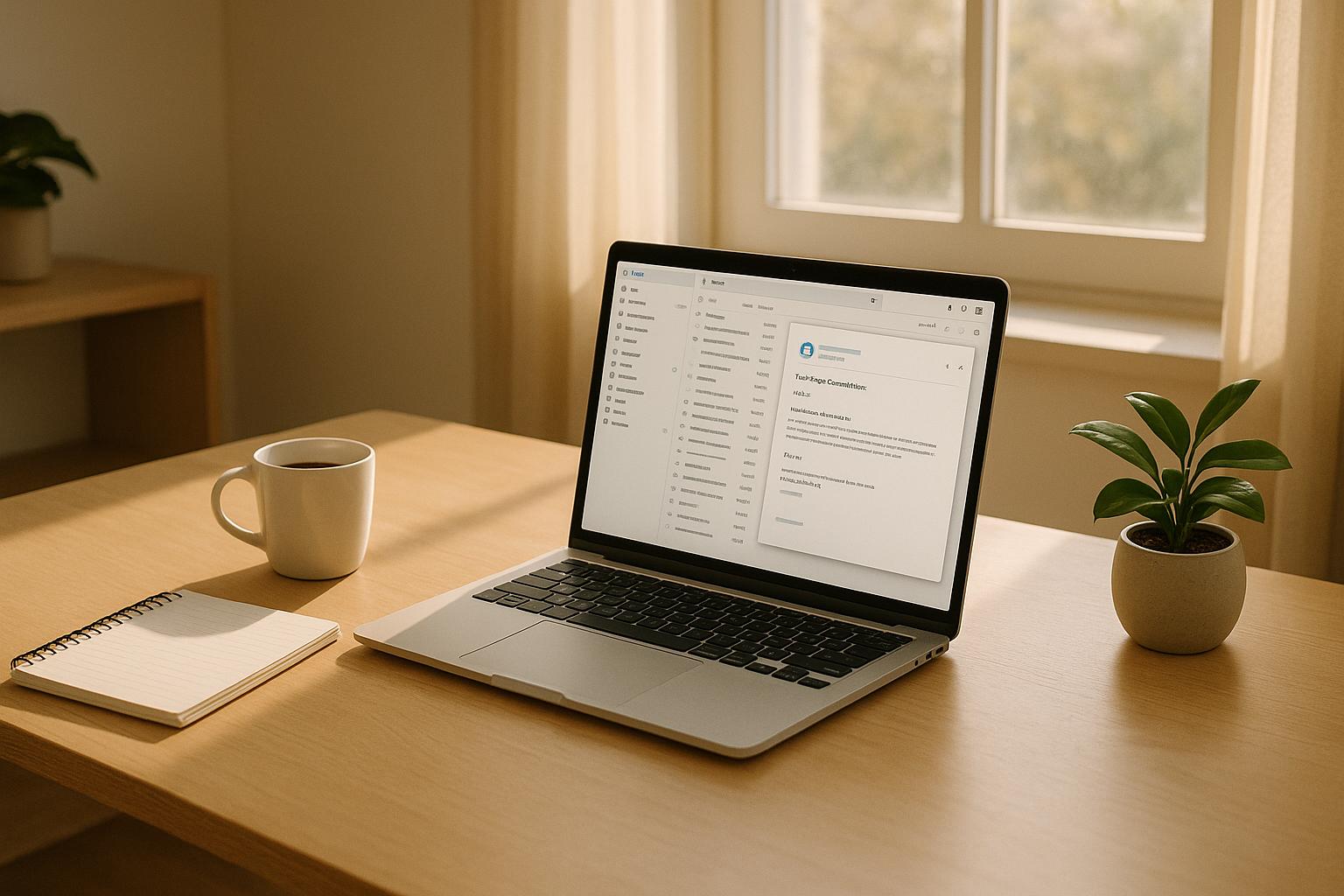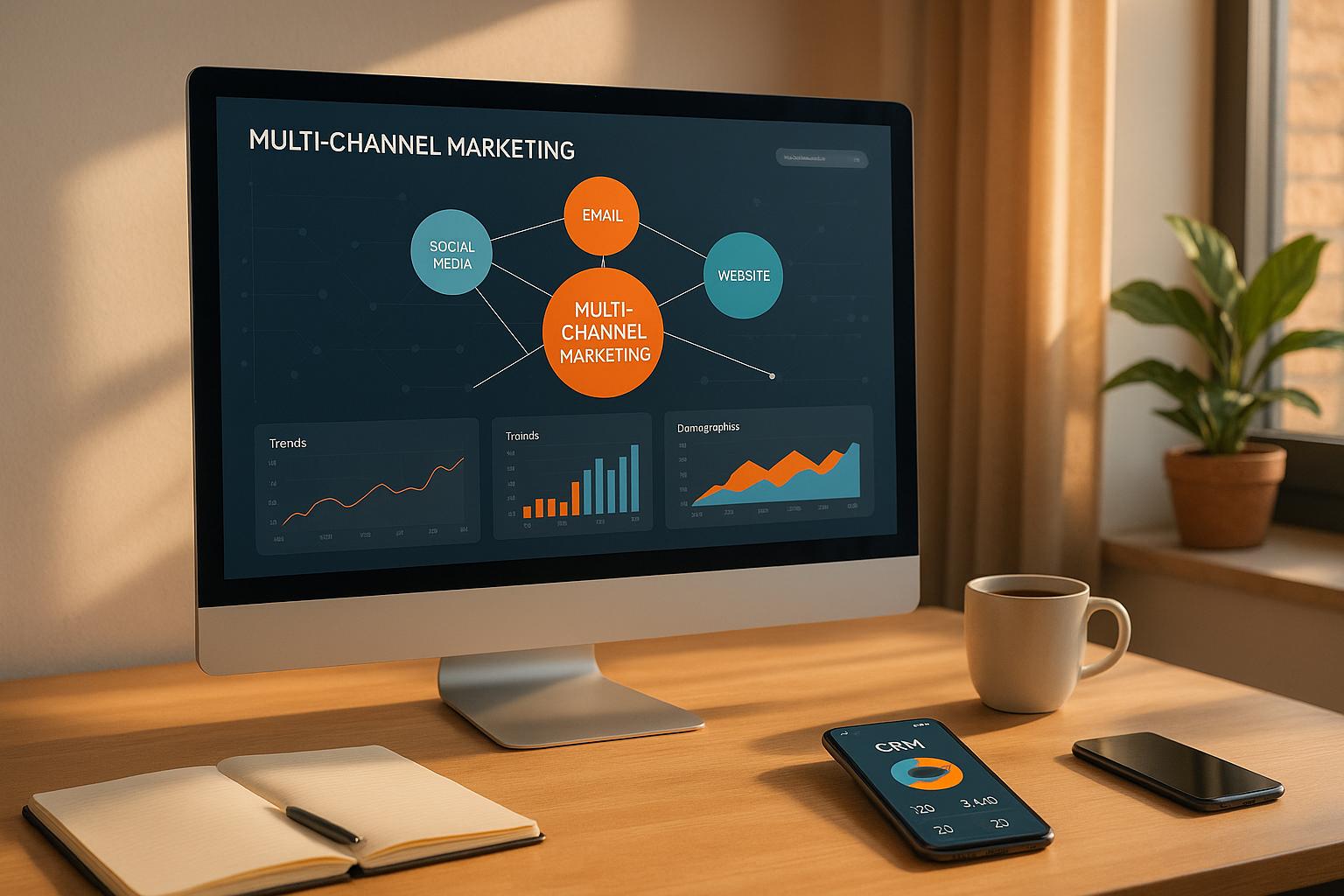Looking to improve your email marketing with multi-stage drip campaigns? Here's what you need to know: drip campaigns are automated email sequences designed to send tailored messages at the right time. They can increase conversion rates by up to 50% and drive 75% of email marketing revenue. Choosing the right platform is crucial for success, and the best tools focus on three key areas:
- Automation: Trigger-based workflows that send emails based on user actions.
- Segmentation: Group audiences by behavior, demographics, or engagement for personalized messaging.
- Analytics: Track performance with metrics like open rates and click-through rates.
Here’s a quick look at some of the top platforms:
- BIGContacts: Combines CRM with email automation, starting at $9.99/month.
- Mailmodo: Offers interactive features and AI tools for custom pricing.
- Flodesk: Flat-rate pricing ($38/month) with unlimited emails and a design-first approach.
- Klaviyo: Perfect for e-commerce with advanced segmentation, starting at $20/month.
- ActiveCampaign: Blends CRM and email tools, starting at $39/month.
- Drip: Tailored for e-commerce, starting at $39/month.
Each platform has unique strengths, from CRM integration to advanced segmentation. Select the one that aligns with your business goals and budget.
How to setup drip email campaigns with real-world examples (step-by-step)
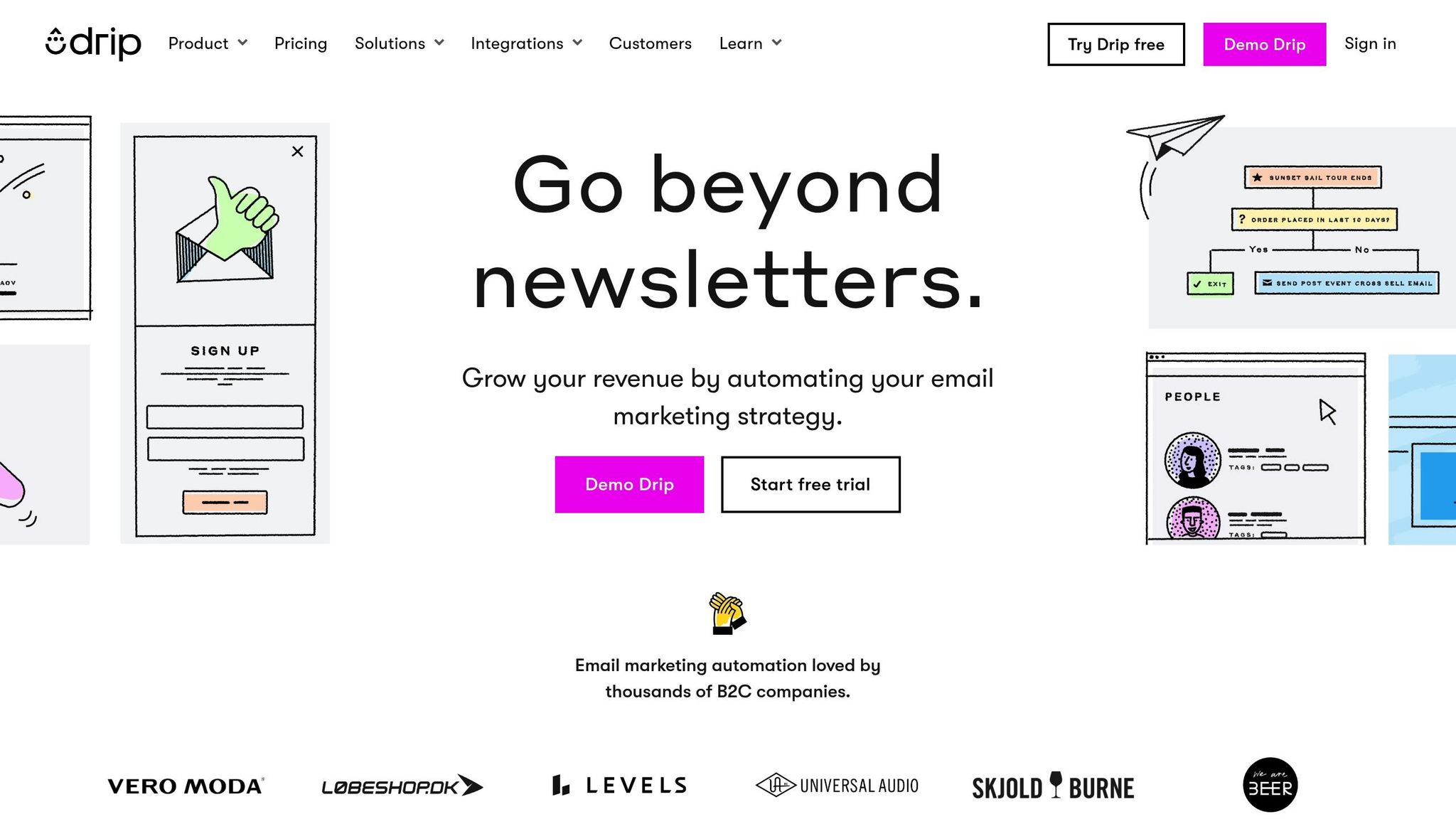
1. Email Service Business Directory
The Email Service Business Directory connects businesses with leading email marketing platforms tailored for multi-stage drip campaigns. These platforms are designed to align with specific automation needs and campaign objectives. Here's a closer look at how they shine in automation, segmentation, and performance tracking.
Automation Capabilities
These platforms specialize in trigger-based automation, sending emails automatically based on user actions - like downloading a resource or signing up for a newsletter. Whether it’s onboarding new users, cross-selling products, recovering abandoned carts, or following up after events, these tools handle it all. Plus, they integrate seamlessly with CRMs and analytics systems, helping businesses achieve click rate increases of up to 119%.
Segmentation Options
The directory highlights platforms with robust segmentation tools that group contacts into specific categories for personalized messaging. Segmentation can be based on demographics, behaviors, or location, ensuring every message reaches the right audience at the right time. Notably, 39% of email marketers using segmentation report higher open rates, and 28% see fewer unsubscribes.
Analytics and Reporting
Top-notch platforms offer detailed tracking of key metrics like open rates, click-through rates, and bounce rates. Bryan Lozano, VP of Operations at Ad-Apt, emphasizes the importance of clear and actionable reporting:
"A great email marketing report is straight to the point, highlighting the key performance indicators for the analysis timeframe, and providing actionable insights".
Pricing (USD)
The directory offers three pricing tiers to accommodate businesses of all sizes:
- Boost Plan: $299/month for small businesses, supporting 1,000 contacts with essential tools and basic analytics.
- Advanced Plan: $999/month for growing companies, supporting 10,000 contacts with full automation features and CRM integration.
- All In Plan: $2,999/month for enterprises, offering unlimited contacts, complete feature access, and priority customer support.
This flexible pricing structure ensures businesses can find a solution that fits their budget while scaling their email campaigns as they grow.
2. BIGContacts
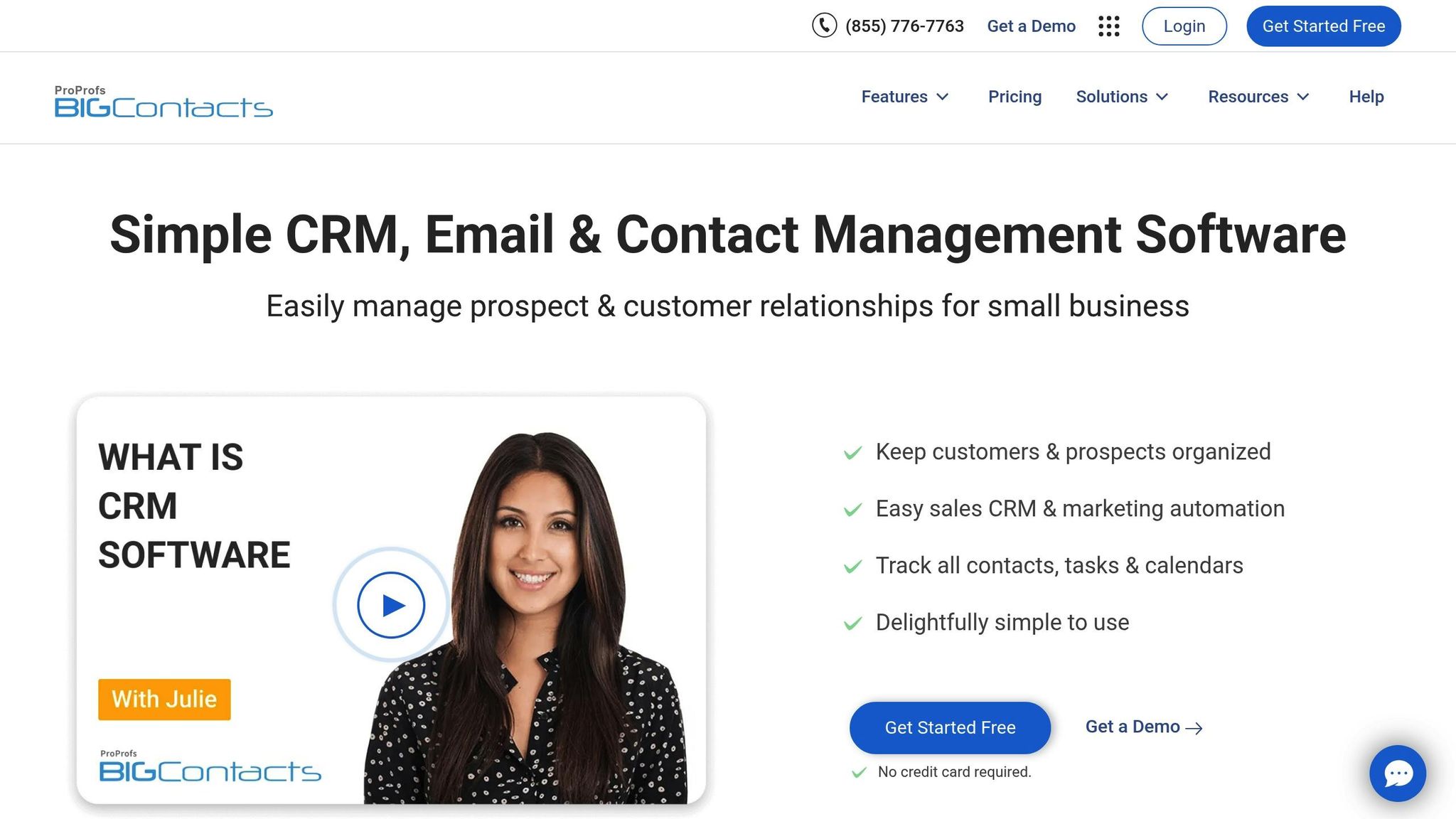
BIGContacts combines CRM tools with email automation to simplify multi-stage drip campaigns, making it especially handy for small businesses. By integrating contact management with automated email sequences, it helps businesses nurture leads more effectively.
Automation Capabilities
BIGContacts uses trigger-based automation to respond to contact behaviors and campaign stages. This means you can set up automated email sequences with custom triggers, creating tailored customer journeys and managing follow-ups automatically. Considering that automated emails can drive 320% more revenue than non-automated ones, and effective lead nurturing increases sales opportunities by 20%, this feature can make a big difference.
As BIGContacts puts it:
"BIGContacts is a powerful CRM software that offers marketing automation functionality to help you nurture and convert more leads."
This automation also supports detailed audience segmentation, ensuring personalized interactions.
Segmentation Options
BIGContacts allows you to organize contacts into static or dynamic lists for more targeted communication. Segmentation can be based on factors like demographics, preferences, needs, or sales cycle stages, using customizable fields and tags. This is crucial, as 71% of customers expect brands to communicate with them personally, and segmented campaigns can increase revenue by a staggering 760%.
Analytics and Reporting
The platform provides robust analytics and reporting tools to track how well your drip emails are performing. You can access detailed reports and real-time metrics to understand lead engagement and overall campaign success. These insights help you fine-tune your campaigns for better results.
Pricing (USD)
BIGContacts offers a paid plan starting at $9.99/month and a Forever Free plan with premium features tailored for startups. This combination of functionality and affordability makes BIGContacts a strong contender for businesses looking to optimize their drip campaigns.
3. Mailmodo
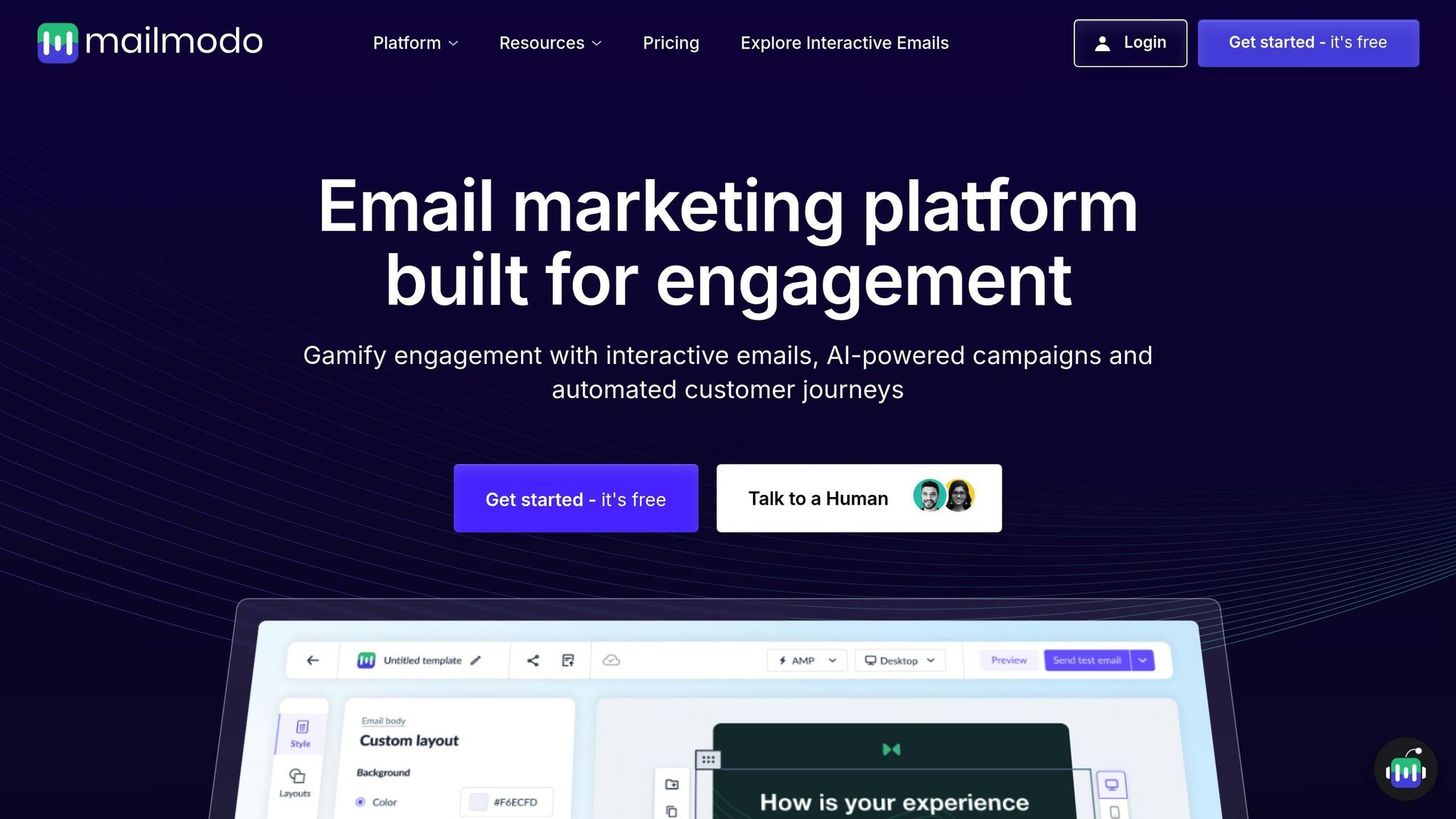
Mailmodo combines automation with interactive features to help businesses create multi-stage drip campaigns that engage audiences and boost conversions.
Automation Capabilities
Mailmodo's visual journey builder simplifies the process of designing intricate drip campaigns. You can create automated email sequences that adapt to user behaviors, like opens, clicks, or form submissions. Need to tweak your campaign? You can easily add or remove email sequences on the fly. The platform also lets you introduce strategic delays between emails to ensure your messages land at the right time.
For added convenience, Mailmodo incorporates AI tools to assist with writing emails and optimizing send times. You can map out the customer journey visually, setting triggers, email counts, delays, and follow-ups, making it easy to track and refine your strategy. This seamless automation is paired with precise audience targeting for maximum impact.
Segmentation Options
Mailmodo’s segmentation tools allow you to group subscribers based on factors like purchase history, engagement levels, or location, making your campaigns more relevant and effective. Whether you prefer dynamic segments that update automatically or static ones you control, the platform offers flexibility. You can even segment based on campaign activity, user properties, or custom events.
What really sets Mailmodo apart is its interactive features. Built-in forms, quizzes, and games not only make your emails more engaging but also lead to higher registrations, feedback, and conversions.
Analytics and Reporting
Mailmodo doesn’t just help you send emails - it also helps you understand their performance. The drip sequence analytics dashboard gives you a clear view of how your campaigns are doing, tracking metrics like open rates, click-to-open rates, and submission rates over customizable time periods.
The dashboard provides a detailed contact overview, showing how many people are still in the journey, how many have completed it, and where drop-offs occur. For broader insights, the Campaign Performance report and Campaign Key Metrics report aggregate data across campaigns, offering filtering options for time periods ranging from the last 7 days to up to 180 days.
"The first step is reverse-engineering the customer journey - where do people drop off, and what information would help them move forward? From there, create a sequence with logical progression rather than random emails." - Ani Ghazaryan, Head of Content at neptune.ai
Pricing (USD)
Mailmodo offers flexible pricing to suit businesses of all sizes. It includes a free plan for those just starting out, while its paid plans scale based on your subscriber count and feature needs. This makes it a great option for small businesses, while still delivering advanced tools for larger organizations.
4. Flodesk
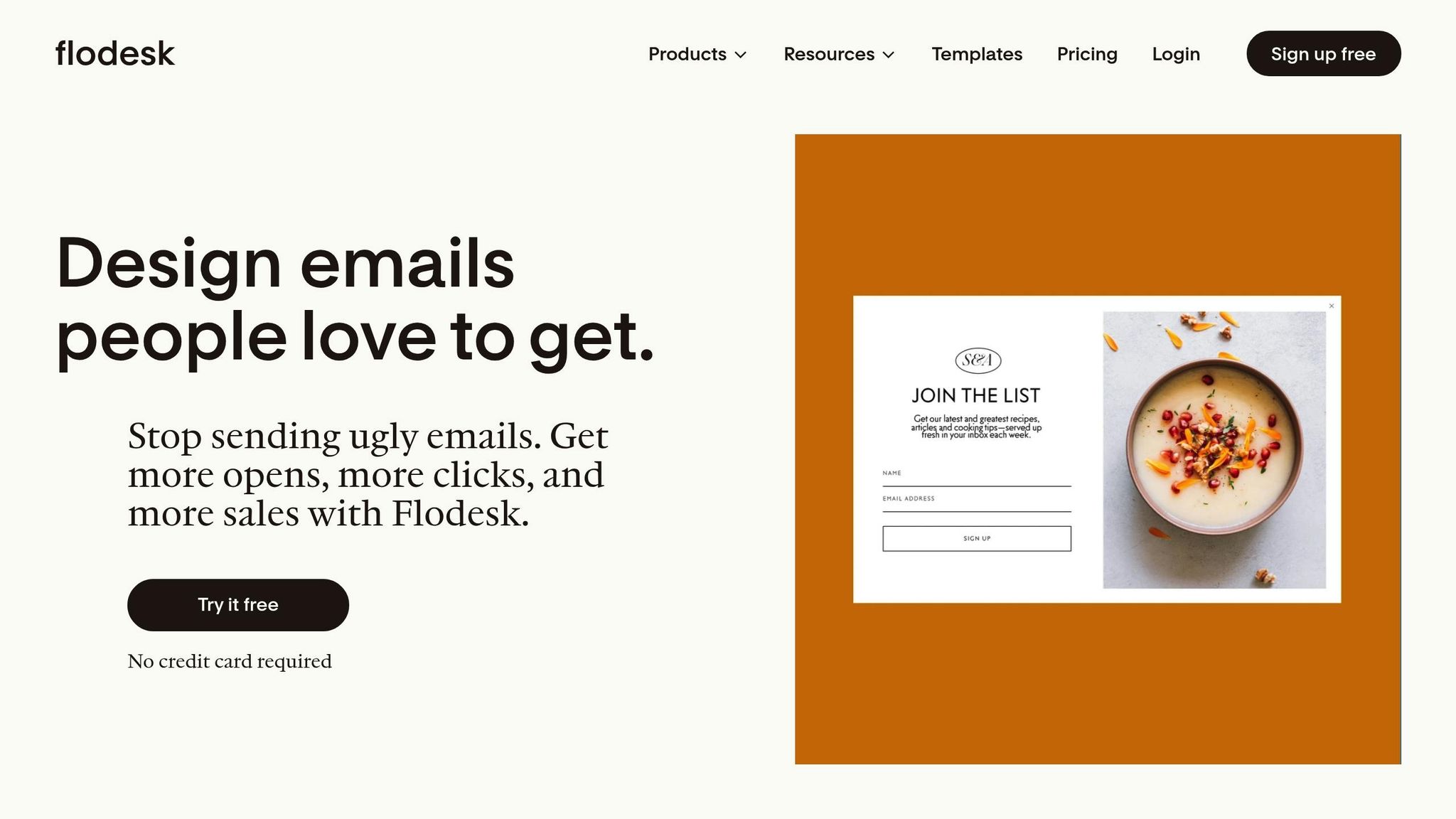
Flodesk takes a design-first approach, making it a standout choice for marketers aiming to create beautiful emails without worrying about subscriber limits. With over 60 million subscriber relationships managed through the platform, Flodesk has proven its ability to deliver effective campaigns.
Automation Capabilities
Flodesk simplifies email automation with its intuitive visual workflow builder. Whether you're setting up welcome sequences, sales funnels, post-purchase follow-ups, or delivering freebies, the platform makes the process seamless. It offers unlimited automations, subscribers, and email sends.
Triggers are highly customizable, allowing for automation based on checkout sales, email opens, link clicks, time delays, or custom fields. Subscribers can re-enter workflows whenever triggers are met, and you can launch these workflows directly from opt-in forms or by using pre-existing segments. For example, you can automatically send a freebie to new subscribers, schedule birthday or anniversary emails with special discounts, or recover abandoned carts. Beyond that, you can maintain engagement with time-sensitive discounts, personalized product suggestions, or alerts for trending items.
Segmentation Options
Flodesk’s segmentation tools enable tailored communication, which 91% of customers say they prefer when shopping with brands. From the moment subscribers opt in, you can organize them based on their preferences and behaviors. Existing subscribers can also be segmented in bulk or automatically based on actions like opening emails, clicking links, or purchasing products.
This personalized approach pays off - marketers have seen up to a 760% increase in revenue from segmented campaigns. Birthday emails, for instance, generate 342% more revenue, while abandoned cart emails convert nearly 20% of the time. And all of this is paired with Flodesk’s simple, transparent pricing.
Pricing (USD)
Flodesk offers a flat-rate pricing model that sets it apart in the email marketing space. Here’s a breakdown of its plans:
- Free: $0/month – includes basic list-building tools.
- Email: $38/month (or $35/month billed annually) – includes unlimited emails and subscribers.
- Email + Checkout: $59/month billed annually (or $64/month billed monthly) – includes e-commerce features.
No matter how many subscribers you have, the price stays the same.
This pricing model has earned praise from users. Janeen I, CEO at Writing and Editing, shared:
"I haven't found another platform that is easier. Plus, Flodesk has a monthly payment for unlimited subscribers, which is phenomenal and affordable."
Laurie S, Director of Marketing and Advertising, echoed this sentiment:
"It is so much better priced than competitors, I can send multiple emails per month without worrying about it costing too much."
Flodesk’s user-friendly design has also been widely recognized. In 2025, it received the Best Ease of Use badge in the email marketing category, with an average Capterra user rating of 4.3/5.
sbb-itb-6e7333f
5. Klaviyo
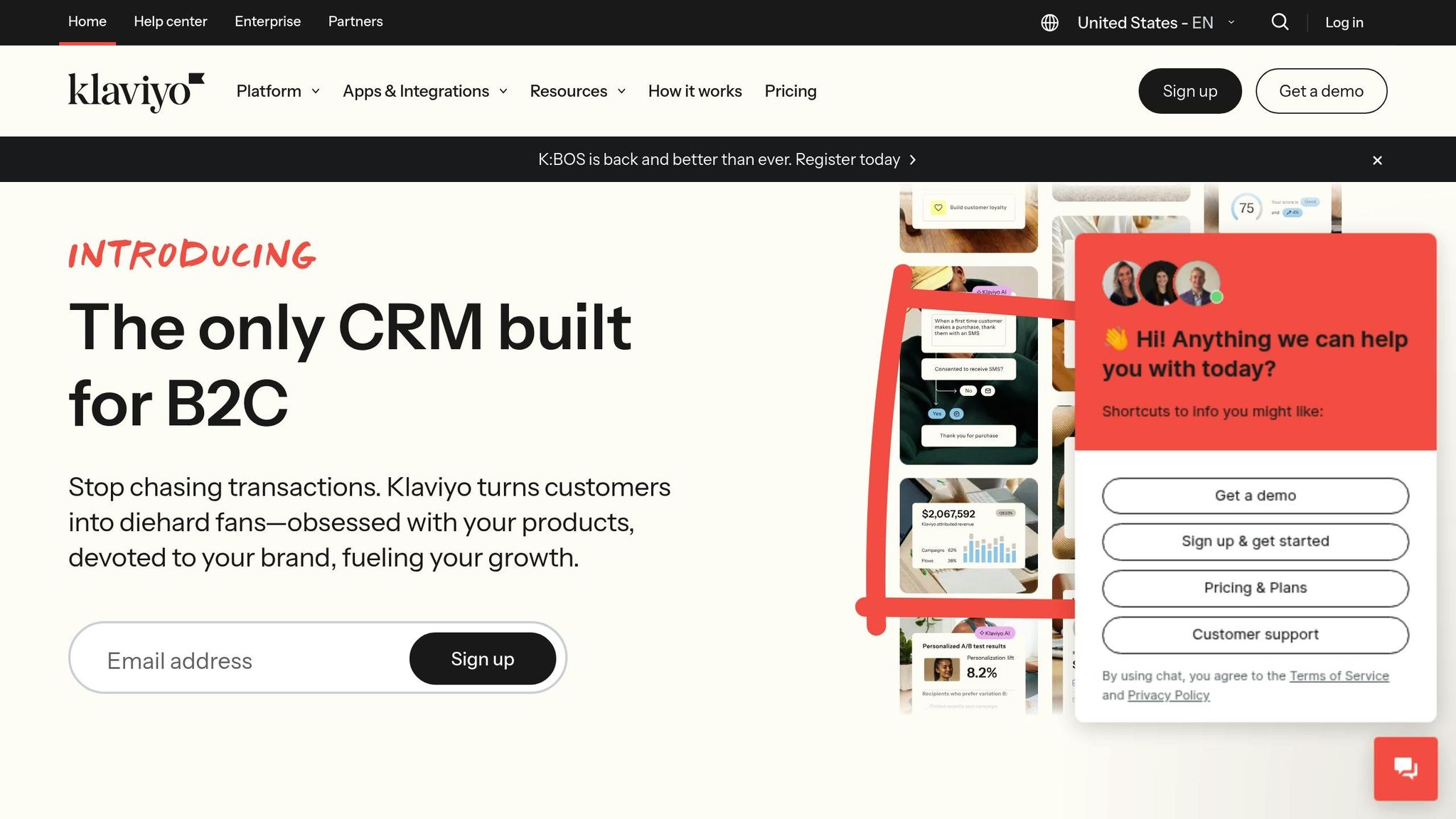
Klaviyo is a platform that merges email marketing with rich customer insights, offering businesses the tools they need to design complex, multi-stage campaigns. These campaigns adapt in real time to customer behavior and preferences, making it a go-to for brands aiming to create personalized experiences.
Automation Capabilities
Klaviyo stands out for its automation features, particularly its robust flow system. These "flows" are automated sequences triggered by customer actions, milestones, or events. With over 60 pre-built templates and a drag-and-drop builder, businesses can design flows that combine email, SMS, and push notifications into a single, seamless customer journey across multiple channels. The platform even supports webhooks, enabling actions like sending thank-you cards or awarding loyalty points through integrated apps.
One of Klaviyo's standout features is its split logic, which allows businesses to create conditional splits within flows. This ensures messages are tailored based on customer characteristics or specific actions that triggered the flow. To further optimize campaigns, Klaviyo includes A/B testing, letting users experiment with variables like send times, content, channels, and discount offers.
For example, Wilkinson Sword leveraged Klaviyo’s behavioral targeting to great effect. John Pagni, ecommerce assistant at Edgewell, shared:
"We retarget people based on what they've clicked within an email. After they click, we send them another email that's directly related to what they expressed an interest in. Through that we get really high open rates - around 60 percent - and also a really strong conversion rate."
Segmentation Options
Klaviyo takes targeting to the next level with its real-time segmentation tools. These tools continuously update, ensuring your messages reach the most relevant audience. By analyzing customer data - such as browsing habits, purchase history, form responses, and even predictive analytics like churn risk and lifetime value - Klaviyo helps businesses create highly targeted segments. The Segments AI feature simplifies this process, allowing users to describe their audience and let the platform handle the rest.
Many brands have seen measurable success using Klaviyo’s segmentation capabilities. Huda Beauty, for instance, doubled its year-over-year growth in Klaviyo-attributed revenue by focusing on engaged subscribers, targeting only those active within the past 120 days for regular campaigns and reserving full-list emails for major sales. Andie Swim used a fit-finder quiz to segment their list by style preferences, generating over $70,000 in additional revenue in just eight months. Meanwhile, Compass Coffee encouraged customers to submit photos alongside reviews, offering discounts as incentives. This strategy led to a 3.7x increase in customer photo submissions and a 70.5% rise in total reviews.
Victor Montaucet, CEO of Ben&Vic, summed it up well:
"The more you know your subscribers/customers, the more you'll be able to segment your database and your sendings."
Analytics and Reporting
Klaviyo provides detailed reporting tools that integrate seamlessly with your campaigns, flows, and segments. With connections to over 350 tools, the platform allows you to track metrics across various channels, including website activity, subscriptions, and overall marketing engagement. Users can choose from pre-built templates or create custom reports to analyze message performance, business metrics, and channel effectiveness. Additionally, benchmarks allow you to compare your results with industry peers.
The Moret Group found Klaviyo’s unified reporting particularly useful. Christopher Peek, their digital marketing director, explained:
"I'm not pulling 3 different reports from 3 different platforms and trying to connect the dots. I love being able to go in and see how each message performed with each RFM segment."
Klaviyo also offers A/B testing and global holdout groups, giving businesses the tools to fine-tune their strategies based on actionable insights.
6. ActiveCampaign
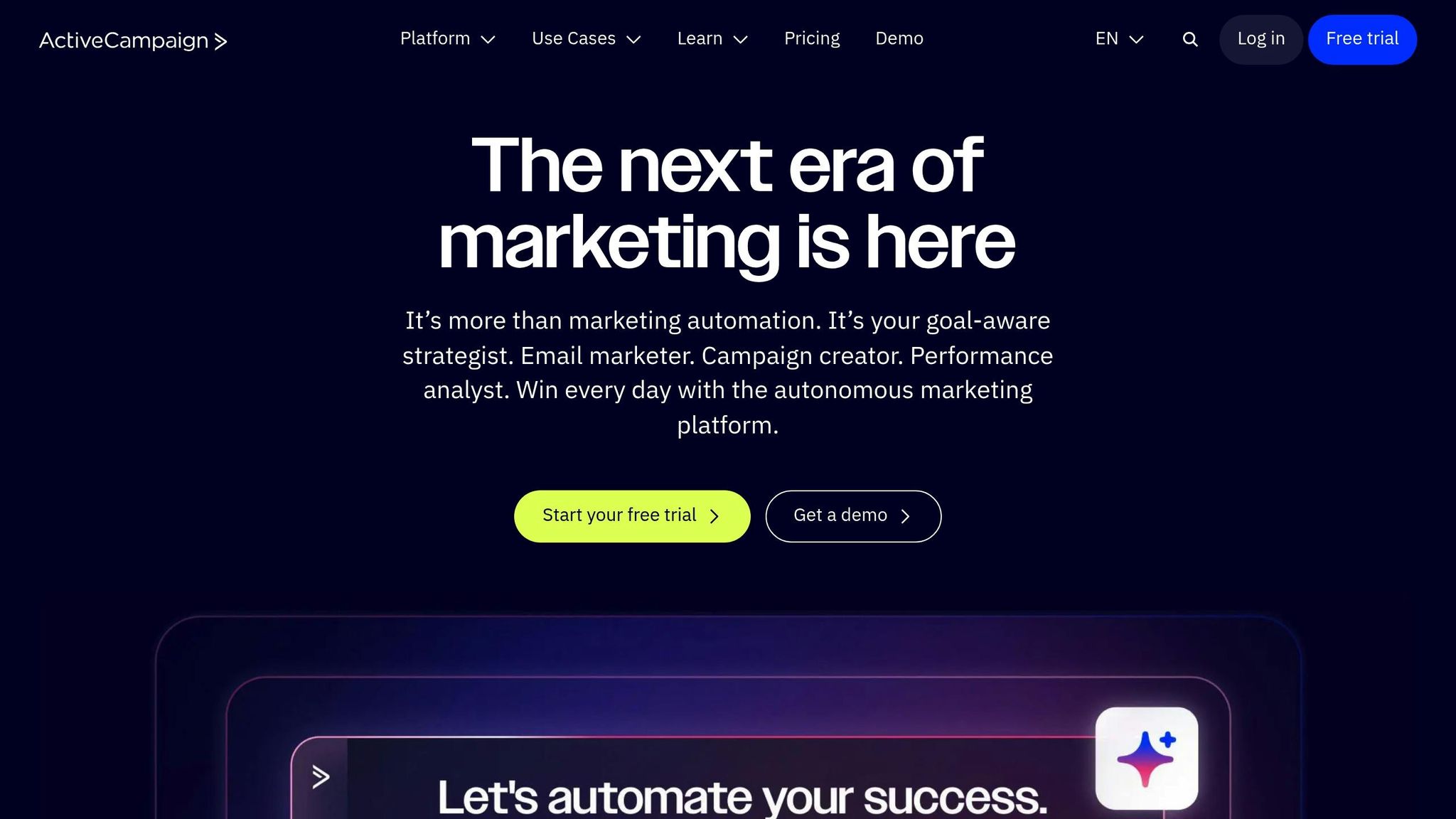
ActiveCampaign promotes itself as more than just an email marketing tool - it’s a full-scale marketing platform designed to handle complex automation workflows. It’s particularly effective at creating personalized, real-time interactions within multi-stage drip campaigns. What sets it apart is its ability to adapt automatically to customer behavior, making it a strong choice for guiding leads through intricate sales funnels.
Automation Capabilities
The automation features in ActiveCampaign are both powerful and versatile. Users can design workflows that combine triggers, actions, and logic, ensuring smooth and relevant customer journeys. These workflows can respond instantly to actions like website visits or email opens, tailoring interactions to individual behaviors.
ActiveCampaign also excels in lead management. Its multi-dimensional lead scoring system can pause drip campaigns when a customer books a demo or completes a purchase, ensuring communications remain timely and relevant. It automatically applies tags and notes to contacts, giving sales teams valuable insights. Additionally, the platform can seamlessly shift prospects between campaigns and deliver personalized content based on user characteristics.
For added clarity, the platform includes visual campaign blueprints. These maps illustrate email sequences and user actions, making it easier to design and refine complex workflows.
Segmentation Options
ActiveCampaign complements its automation tools with robust segmentation capabilities, allowing for highly targeted audience engagement. Its segment builder pulls from a wide range of data points, including contact details, custom fields, geographic location, actions, events, deals, and more. AI-driven tools simplify segment management, reducing manual tasks while providing greater precision in audience targeting.
Segmentation is dynamic, meaning contacts are automatically sorted into the right groups as they interact with your content. With integrations to over 850 apps, ActiveCampaign can gather data from various sources, creating detailed customer profiles that enhance targeting efforts.
Analytics and Reporting
ActiveCampaign rounds out its feature set with robust analytics and reporting tools. Its dashboards provide a comprehensive view of campaign performance across multiple channels, making it easy to track results at a glance. The Campaigns Performance Report offers insights into key metrics like open rates, click rates, emails sent, deliverability, and revenue attribution. Users can filter campaigns by type and compare performance over different time periods for deeper analysis.
Beyond email performance, the platform tracks user activity across websites, monitors deals, evaluates pipeline health, and analyzes form completions and app events. Customizable reporting options allow businesses to focus on the metrics that matter most to them.
For optimization, ActiveCampaign includes split testing tools to refine campaign elements. Additionally, its hourly open trend analysis helps determine the best times to send emails for maximum engagement.
7. Drip
Drip is a marketing automation platform tailored for ecommerce businesses. It helps drive customer engagement and boost sales by using advanced behavioral tracking and adaptive messaging. What sets Drip apart is its ability to adjust communications based on where customers are in their buying journey. This makes it ideal for creating multi-stage campaigns that align with every customer interaction.
Automation Capabilities
Drip’s automation features are built around ready-to-use templates that make setting up funnels quick and easy. You can schedule emails to go out automatically based on customer actions or preset marketing strategies, ensuring your messages align with critical moments in the sales cycle.
The platform’s workflows are user-friendly, allowing marketers to create conditional rules triggered by specific actions. For example, a customer might enter a workflow after clicking a link, submitting a form, or receiving a tag. This behavior-driven system ensures every subscriber gets content that matches their interactions with your brand.
"Drip has made my life as a marketer so much easier. It's innovation lies in its simplicity. The Onsite popups blew my mind, and the workflows are so easy to use." - Tom Maya, Head of Marketing at We Are Beer
A standout feature is Drip’s ability to sync order data, enabling businesses to send personalized emails based on purchase history and behavior. This seamless integration supports targeted segmentation, helping businesses craft more effective multi-stage campaigns.
Segmentation Options
Drip enhances its automation capabilities with behavior-based segmentation, allowing businesses to fine-tune the customer journey. Marketers can filter their email lists by specific behaviors and save these segments for targeted campaigns. These segments automatically update as customers engage with your brand, ensuring your messaging stays relevant over time.
According to a MailChimp study, segmented email campaigns can lead to 14.31% more opens, 100.95% more clicks, and 9.73% fewer unsubscribes compared to non-segmented campaigns. Drip users who leverage segmentation reportedly earn five times more revenue than those who don’t. Lindsay Dryer from Haute Hijab exemplifies this by tailoring messages to align with customer needs at different stages of their journey, using automated workflows to guide them seamlessly.
Analytics and Reporting
Drip provides detailed insights into campaign performance and revenue attribution. Marketers can track how workflows contribute to sales and analyze customer behavior trends that lead to conversions. This data-driven approach helps businesses identify which segments and automation strategies are driving the best results, enabling ongoing campaign optimization.
Pricing (USD)
Drip’s pricing is based on the number of contacts in your list, starting at $39 per month for up to 2,500 subscribers with unlimited email sends. All plans come with a 14-day free trial, no credit card required. Key features like A/B testing, free migration, onsite campaigns, and chat and email support are included in every plan. It’s important to note that Drip charges based on the highest number of active users during the billing cycle, not the current count.
Here’s a breakdown of the pricing:
| Monthly Price | Subscribers | Email Sends |
|---|---|---|
| $39-$89 | 1-5,000 | Unlimited |
| $99-$154 | 5,001-10,000 | Unlimited |
| $169-$369 | 10,001-25,000 | Unlimited |
| $409-$699 | 25,001-50,000 | Up to 600,000 |
| $749-$1,199 | 50,001-100,000 | Up to 1,200,000 |
| $1,249-$1,699 | 100,001-150,000 | Up to 1,800,000 |
| $1,699-$1,999 | 150,001-180,000 | Up to 2,160,000 |
| Custom | 180,000+ | 2,220,000+ |
Businesses using Drip have seen impressive results. For instance, Nifty Gifts boosted revenue by 77% in just two months and now enjoys up to 122% higher average order values. Similarly, Ben Grynol from Levels Health shared that 30% of their revenue now comes from Drip campaigns.
Tool Comparison Table
Choosing the right email marketing platform for multi-stage drip campaigns can feel overwhelming. To simplify the process, here’s a breakdown of some top tools, highlighting their features, pricing, and the types of businesses they suit best. Use this table as a quick reference to match a platform to your needs.
| Tool | Key Features | Starting Price (USD) | Best For | G2/Capterra Rating |
|---|---|---|---|---|
| Email Service Business Directory | Curated recommendations and comparison tools | $299/month (Boost plan) | Businesses needing expert email service guidance | N/A |
| BIGContacts | Automated drips, analytics, static & dynamic contact lists | $9.99/user/month | Small to medium businesses requiring CRM integration | N/A |
| Mailmodo | Interactive campaigns, AMP emails, drag-and-drop editor | Custom pricing | Businesses seeking interactive email experiences | N/A |
| Flodesk | User-friendly builder, pre-designed templates, automation | $38/month (flat rate) | Creative brands, bloggers, and visual-focused businesses | N/A |
| Klaviyo | Ecommerce segmentation, SMS integration, predictive analytics | $20/month (500 contacts) | Ecommerce stores, especially Shopify users | 4.6/4.6 |
| ActiveCampaign | CRM integration, advanced automation, triggered emails | $39/month (1,000 contacts) | Small-to-mid-sized businesses needing CRM + email tools | 4.5/4.6 |
| Drip | Behavioral tracking, ecommerce focus, order data sync | $39/month | B2C ecommerce brands and online retailers | N/A |
The pricing models and features vary significantly depending on the platform and your subscriber count. For example, Flodesk offers a flat rate of $38/month for unlimited subscribers, while BIGContacts starts at $9.99 per user per month.
If you’re in ecommerce, Klaviyo and Drip stand out. Klaviyo provides robust segmentation tools and predictive analytics, making it a top pick for Shopify-based businesses. Drip focuses on behavioral tracking and adaptive messaging, tailored for B2C ecommerce brands.
For businesses needing both email marketing and CRM solutions, ActiveCampaign offers a seamless integration of these tools. Its advanced automation features and strong ratings - 4.5 on G2 and 4.6 on Capterra - make it a reliable choice for small-to-mid-sized operations.
Meanwhile, the Email Service Business Directory takes a unique approach by acting as a curated resource to help businesses navigate the email marketing landscape. At $299/month for the Boost plan, it’s more of a consultation service, guiding users toward the best platform for their needs.
Ultimately, your choice depends on your business goals and technical requirements. Ecommerce brands might prioritize specialized platforms like Klaviyo or Drip, while service-based businesses could benefit from the CRM capabilities of ActiveCampaign. Select the tool that aligns with your campaign's complexity and growth potential.
Conclusion
Choosing the right platform for multi-stage drip campaigns boils down to three essential capabilities: automation, segmentation, and analytics. These are the pillars that separate tools delivering actual results from those that merely send emails.
Automation is a game-changer, driving around 75% of email marketing revenue. Pair that with effective segmentation, and the numbers become even more compelling - personalized emails can lead to six times higher transaction rates.
The platforms we've discussed - like Klaviyo with its ecommerce strengths or ActiveCampaign with its CRM integration - shine in different areas. Your decision should reflect your business's unique needs, whether that's seamless Shopify integration, intuitive design tools, or advanced behavioral tracking.
Analytics ties everything together. A platform with strong performance tracking helps you understand what’s working, where you're falling short, and how to refine your campaigns for better outcomes. Without reliable data, improving your strategy becomes guesswork.
Scalability is another critical factor. As your business grows, your platform must integrate smoothly with your existing systems.
For those feeling overwhelmed by the crowded email marketing space, the Email Service Business Directory can simplify your search. This resource offers curated recommendations, helping you avoid platforms with poor performance, low deliverability, or unclear pricing. It highlights key features and pricing transparently, ensuring you select a platform that scales effectively without driving up costs.
Ultimately, the best platform isn’t necessarily the most expensive - it’s the one that fits your technical requirements, works with your existing tools, and delivers the automation and analytics you need to grow.
FAQs
What are the main advantages of using multi-stage drip campaigns in email marketing?
Multi-stage drip campaigns bring several advantages to email marketing, making them an effective tool for connecting with your audience. They allow you to send timely, targeted messages, ensuring your communication remains relevant and engaging. This approach helps create stronger bonds with customers and keeps their interest alive.
Another major benefit is automation. With email workflows running automatically, marketers can save time while nurturing leads more effectively. Instead of manually managing every step, you can guide prospects toward becoming loyal customers with ease. Plus, these campaigns make it possible to achieve personalization on a large scale, making each message feel tailored and meaningful.
In short, multi-stage drip campaigns can elevate customer engagement, increase conversions, and encourage long-term loyalty, making them a cornerstone of successful email marketing strategies.
What should I look for when choosing the best platform for multi-stage drip campaigns?
When choosing a platform for your multi-stage drip campaigns, it's important to focus on features that can streamline your efforts and improve results. Look for tools that offer automation workflows, audience segmentation, and personalization options - these are the building blocks for delivering the right message at just the right time. Equally important is having strong performance tracking so you can measure success and fine-tune your campaigns effectively.
You’ll also want a platform that's easy to use and fits your business's unique needs. Options that include advanced analytics and integrate smoothly with other software can simplify campaign management while boosting efficiency. Make sure the platform aligns with your marketing objectives and the different stages of your customer journey to drive better engagement and higher returns.
What’s the difference between automation, segmentation, and analytics in email marketing platforms?
In email marketing platforms, automation takes the hassle out of repetitive tasks by sending targeted emails automatically. These emails are triggered by user actions or set conditions, ensuring messages are sent at just the right moment with minimal effort. This keeps your communication timely and helps build stronger relationships with your leads.
Segmentation breaks your contact list into smaller, more precise groups based on criteria like demographics, past purchases, or engagement levels. By tailoring your messages to these specific groups, you can deliver content that truly connects with each audience.
With analytics, you can track essential metrics like open rates, click-through rates, and conversions. These numbers give you a clear picture of how your campaigns are performing, allowing you to tweak and refine your strategies for better results in the future.
